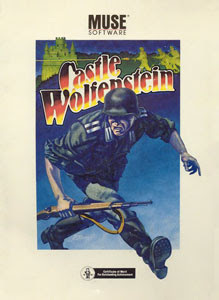Retrospective: Castle Wolfenstein
 As a general rule, I've tried to keep the entries in the Retrospective series focused on roleplaying games, but I've regularly bent that rule over the years. I've often done so when a particular non-RPG product, whether it be a wargame, a boardgame, or even a videogame, played an important role in my own gaming history – and Castle Wolfenstein, like
Telengard
, was a very important game for me.
As a general rule, I've tried to keep the entries in the Retrospective series focused on roleplaying games, but I've regularly bent that rule over the years. I've often done so when a particular non-RPG product, whether it be a wargame, a boardgame, or even a videogame, played an important role in my own gaming history – and Castle Wolfenstein, like
Telengard
, was a very important game for me.Castle Wolfenstein was originally released in 1981 for the Apple II by a company called Muse Software. Muse was headquartered in Baltimore, Maryland, not far from where I grew up, which may explain why I had an inordinate affection for the game. I didn't own a computer of any sort at the time, let alone an Apple II, but a good friend's father owned an Atari 400 and he was very generous in allowing the neighborhood kids to play games on it. An Atari-compatible version of Wolfenstein appeared in 1982 and that was the one I played (once my friend's dad acquired it, of course).
The premise of Castle Wolfenstein was straightforward: you play an Allied spy during World War II who's been captured and consigned to the dungeons beneath the titular castle for interrogation by the SS. Your goal is to locate the secret battle plans you were carrying before your capture and escape the castle. To do that, you first have to find a way out of the dungeon where you're being held. Fortunately for you, another prisoner, who's been hiding in secret, smuggles you a pistol, ammunition, and three grenades before dying. Armed with these, the player must then use his wits to escape the procedurally-generated chambers of the castle.
That may sound like a simple task, but, believe me, it's not. The castle is filled with guards, stormtroopers, and locked doors that impede your progress. To escape, you not only need to marshal your available resources, but also your wits. Though violence is a perfectly acceptable means of dealing with foes, sometimes it's better to avoid them. To this day, I can still hear the distinctive clicking sounds made by a guard marching down a hallway with his back to me. If you timed it just right, you could slip past him and into another area without having to fight him. That was a good option in many cases, because ammunition was limited and combat could be dangerous.
Providing non-violent solutions to some problems was one of the things I really appreciated about Castle Wolfenstein, especially when compared to most other videogames at the time. In addition to outright stealth, you could sometimes find uniforms in the castle that, when worn, would enable you to disguise yourself as a guard and pass unhindered through some areas. Likewise, it was possible under certain conditions to get a guard to surrender to you rather than having to kill him. This wasn't simply a matter of humanitarianism; conserving ammunition was a valuable resource. For times when violence is the only solution, such as when facing stormtroopers, grenades were often the weapon of choice. Grenades were also useful for blasting open doors and walls – and, if you weren't careful, yourself.
My friends and I had a lot of fun with Castle Wolfenstein. The game's premise was compelling and its many features were genuinely innovative for the time. More than that, though, it was one of those rare games that truly rewarded cleverness and patience. This was not an arcade shoot-em-up but an early example of the stealth genre that would develop more fully in years to come. At the time, this was a very novel thing and it inspired us to consider using similar tactics in our roleplaying games. Even now, I think back to the way Castle Wolfenstein provided the player with a variety of viable solutions to many problems. It's a good model for not just videogames but RPG adventures too.
James Maliszewski's Blog
- James Maliszewski's profile
- 3 followers



